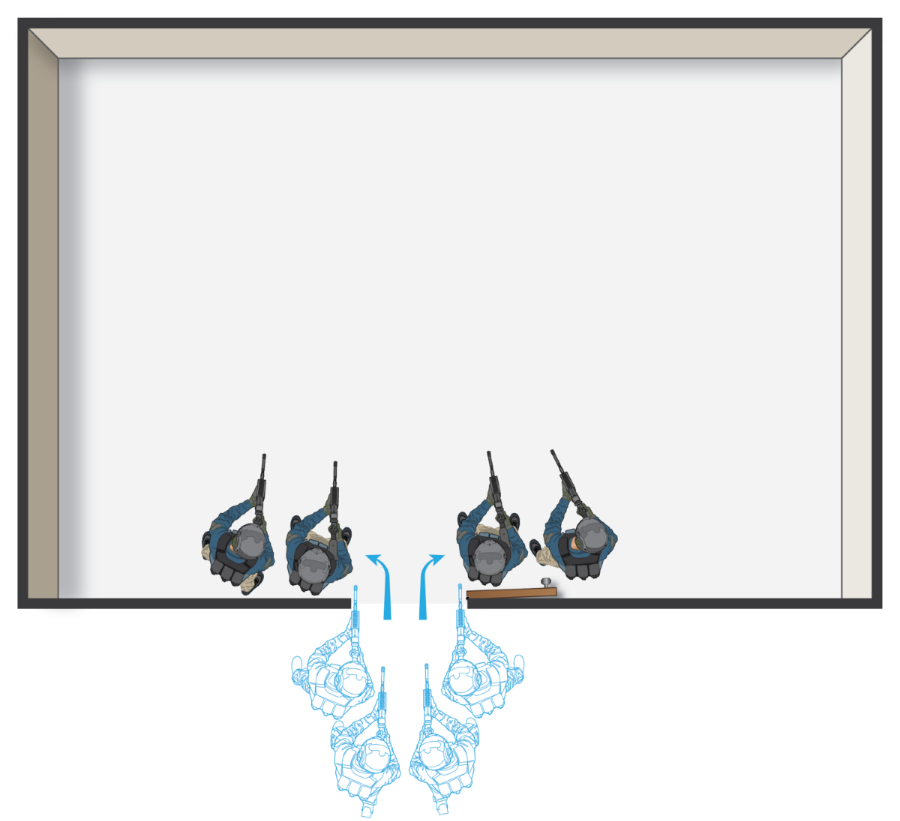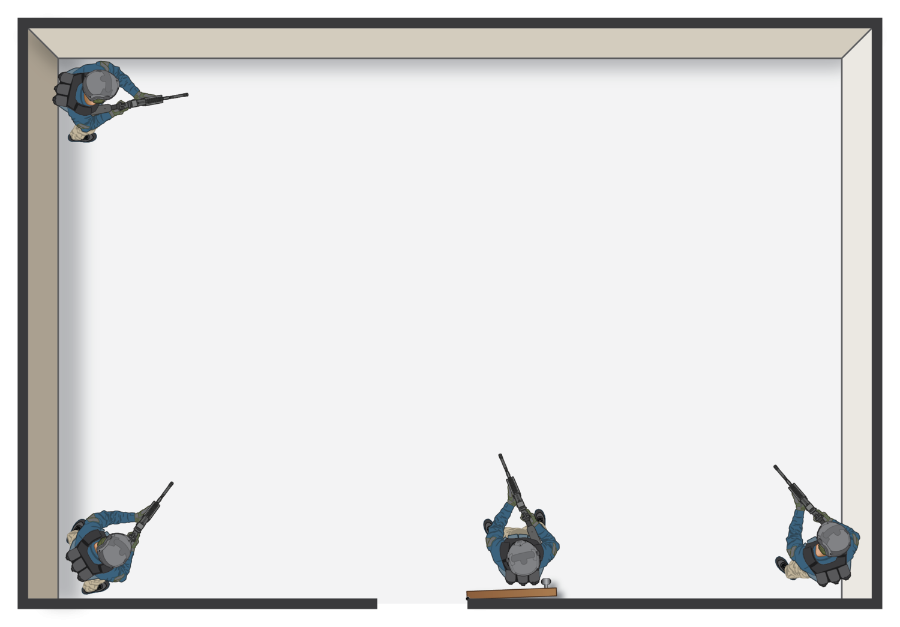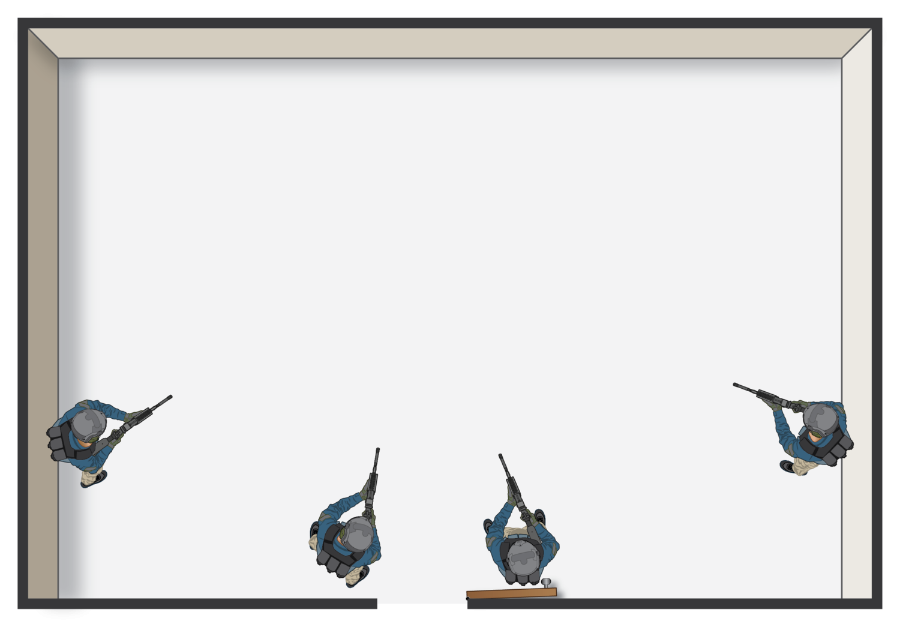Below is one example of a basic limited penetration technique. There are several variations of limited penetration techniques, but they all involve the primary concept of remaining close to the door.

-
The limited penetration technique keeps team members from being drawn too deep into the room where they could be surprised by adversaries from unexpected angles.
-
Keeping team members closer together reduces the risk of fratricide. If a team member penetrates deeper into the room, he may accidentally move into the line of fire of another teammate.
-
By stopping quickly near the door upon entering the room, team members can assume a stationary and stable firing platform sooner. Continuing to move deeper into the room reduces accuracy by forcing team members to shoot on the move.
-
Clearing the room and engaging targets from the doorway allows team members to use the wall for protection before entering the room.*
*Counter-Argument: In most structures (particularly in the United States), walls are constructed of weak materials that will not stop most bullets. Therefore, the wall does not actually provide substantial ballistic protection and should not be used as cover.
-
Limited penetration is especially useful in one-man operations. When fighting alone, many of the disadvantages of limited penetration described in the next section do not apply. For a more detailed discussion of single-person limited penetration (or shallow entry) tactics, see our
Single-Person CQB Manual. For online training based on this manual, see our
Single Person CQB Tactics training course.
-
Remaining very close to the door presents a single, massed target for the adversary. This is particularly problematic when the adversaries have explosives or fully automatic weapons. With team members so close together, a single burst or explosion can incapacitate the entire team. Furthermore, peeking through the doorway while concealing the team behind the wall does not reduce the team’s vulnerability in most cases, since few walls are bulletproof.
-
By not penetrating deeper into the room, the team will have poor angles of observation behind furniture and other obstacles in the room. Combined with the team’s lack of dispersion, this becomes even more problematic. A solitary adversary concealed behind an obstacle deeper in the room can toss a grenade or spray automatic fire blindly over the obstacle and have a concerningly high chance of hitting the team. It is likely that no team member will have a clear shot to engage the adversary.
-
-
-
The points of domination technique involves the tactical team rapidly penetrating deep into a room and assuming points of domination with interlocking fields of fire from two to three of the room’s corners.
Below is an example of the points of domination approach to room entry, as commonly depicted in multiple open-source military publications and presentations.

-
By spreading out across the room, team members capitalize on the tactical advantages of dispersion. Adversaries will be unable to engage the entire team with one burst of fire. If one team member is shot, there is a better chance that the other team members will be able to return fire safely.
-
By entering the room and peeling off in different directions, the team creates a visual effect that confuses the adversary and makes it more challenging for him to acquire and engage targets. As he sees the first team member peel off in one direction and begins to track the target, the second team member peeling off in the other direction will momentarily distract the adversary’s aim, pulling his attention in the opposite direction. It is much more challenging to hit moving targets than it is to hit a stationary target.
-
By penetrating deep into the room, the team can immediately clear behind furniture and other obstacles deep in the room, preventing a concealed adversary from popping up to throw a grenade or spray automatic fire.
-
-
-
Quickly penetrating deep into the room is dangerous because it exposes a team member to several angles from which an adversary can engage unexpectedly.
-
When team members are moving deep into the room, it is easier for team members to accidentally shoot each other when adversaries pop up between two team members.
-
-
-
-
When team members keep moving, rather than stay close to the door, it takes longer for each team member to adopt a stationary, stable firing platform. Team members must shoot on the move — which is less accurate.
Because both techniques have pros and cons, we suggest not sticking rigidly to either technique. How far a team penetrates into a room should depend on the situation. Ideally, tactical teams should maintain flexibility in their SOPs to adjust on the fly, and this aligns with the “free-flow” mindset we strongly advocate for CQB tactics.
Therefore, we suggest a balanced approach in which the team assumes a “shallow horseshoe” configuration in the room, as shown below. This strikes a balance between limited penetration and points of domination, while providing flexibility to allow team members to adjust or modify the depth of their penetration as needed, based on the situation.

-
By using an SOP that does not rigidly dictate how far a team penetrates into the room, the team can adjust the depth of penetration according to the situation. In some cases, the team may remain closer to the door. In other cases, the team may elect to penetrate deeper to clear behind furniture, half walls and other obstacles.
-
A flexible SOP can be adjusted on the fly. The team may initially execute a shallow penetration but choose to penetrate deeper as required or warranted.
-
By using the “shallow horseshoe” configuration, the team still takes advantage of the dispersion and distraction effects of the traditional points of domination technique. However, by keeping the penetration fairly shallow, they avoid the dangers of penetrating too deep into the room.
-
-
-
By not penetrating too deep into the room, the team reduces the risk of fratricide.
-
The shallow horseshoe gives team members better angles of observation to clear behind furniture and other obstacles deeper in the room, as opposed to the angles provided by more limited penetration.
-
Having the third and fourth team members stop next to the door allows them to quickly get their guns into the fight from a stationary, stable firing platform earlier than in the traditional points of domination technique. This improves accuracy by reducing the potential need to shoot on the move.
NOTE: This discussion focuses solely on techniques utilized when entering the room. There are other situations in which the team may want to minimize exposure by not entering the room. In these situations, the team should use the “sweep” technique (slice the pie) or other delayed entry techniques, which are discussed in other articles.



